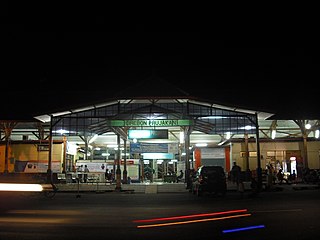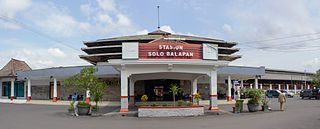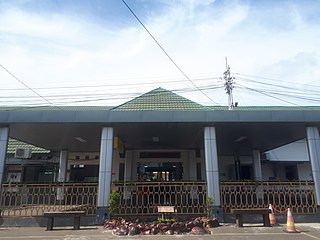
The majority of Indonesia's railways are on Java, used for both passenger and freight transport. There are three noncontinuous railway networks in Sumatra while two new networks are being developed in Kalimantan and Sulawesi. Indonesia has finalized its plan for a national railway network recently. According to the plan, 3,200 km of train tracks will crisscross the islands of Sumatra, Java, Kalimantan, and Sulawesi. It has been touted as the most extensive railway project in Indonesia since its independence from the Dutch in 1945. Indonesia targets to extend the national railway network to 10,524 kilometres by 2030. As of September 2022, the network spans 7,032 km.

PT Kereta Api Indonesia (Persero) (lit. 'Indonesian Railways (State-owned) Limited', abbreviated as PT KAI or simply KAI) is a major railway operator in Indonesia and one of the public railway companies in the country. It is state-owned and pays track access charges. Its headquarters are located in Bandung, West Java. In 2019, KAI carried 429 million passengers and 47.2 million tonnes of cargo.

Jakarta Kota Station is a railway station, located in the old city core of Kota, Jakarta, Indonesia.

Gambir Station is a major railway station in Gambir, Gambir, Central Jakarta, Jakarta, Indonesia. The station is located on the eastern side of Merdeka Square and the western side of the Pramuka Movement headquarters and Immanuel Church. It is operated by the KAI.

Cirebon Station also known as Cirebon Kejaksan Station is the main railway station in the Cirebon area located on Siliwangi Street, Kebonbaru, Kejaksan, Cirebon City, West Java Province. The station is located at DAOP 3 area as North Cross Line, but in this station there is also cross line in Purwokerto Station which is connected by South Cross Line in Kroya Station. Therefore, most of the trains both north and south lines stopped at this station, except economy class train which is stop at Cirebon Prujakan.

Cirebon Prujakan Station (CNP) is a railway station in Cirebon, West Java, Indonesia. The station is located at a height of 4 metres above sea level. It is located at Nyimas Gandasari Street, Pekalangan, Pekalipan, Cirebon. Cirebon Prujakan Station is the largest station on DAOP 3 Cirebon after Cirebon Station and Jatibarang Station.

Jatinegara Station (JNG) is a large type A-class railway station located on the border between Jatinegara and Matraman in Pisangan Baru Subdistrict, Matraman, East Jakarta. The station is the main entrance to Jakarta from cities east of Jakarta. Jatinegara station is operated by Kereta Api Indonesia and KAI Commuter.

Jatibarang Station is a railway station at Mayor Sangun Street (Market), Jatibarang, Jatibarang, Indramayu Regency, West Java. It is on the main northern Java route line from Jakarta to Surabaya.

Bojonegoro Station is the largest railway station in Sukorejo, Bojonegoro, Bojonegoro Regency, East Java. The station is owned and operated by PT Kereta Api Indonesia.

Argo Bromo Anggrek is the name of executive and luxury train jointly operated by Kereta Api Indonesia between Surabaya and Jakarta in Indonesia. The train covers 720 kilometres (447 mi) in 8 hours and 5 minutes along Java's north coast, stopping at Bojonegoro, Semarang Tawang, Pekalongan, and Cirebon. It is one of the best known trains in Indonesia.

Solo Balapan Station is a major railway station in Surakarta, Central Java, Indonesia. The name "Balapan" is taken from the name of a village which is located to the north of the station. The station is located on the railway line that connects the cities of Bandung, Jakarta, Surabaya, and Semarang. Solo Balapan Station is the largest station in Surakarta and Central Java.

Bekasi Station (BKS) is a railway station located in Marga Mulya, North Bekasi, Bekasi, West Java. The station is at an altitude of +19 meters above sea level. This station serves the KRL Commuterline and inter-city trains.

The Bimatrain is an executive class train service with sleeper carriages that is operated by PT Kereta Api Indonesia (Persero) in Java with the service running between Gambir Station (GMR) - Surabaya Gubeng Station (SGU) and vice versa. The train covers 820 kilometres in 10 hours 35 minutes. Bima was initially an acronym for "Biru Malam".

Argo Parahyangan, also commonly known as GOPAR or Gopar for short, is an executive and economy premium class train operated by Indonesian Railway Company between Gambir railway station, Jakarta and Bandung in Java, Indonesia. The train covers 166 kilometres (103 mi) in 2 hours 50 minutes. From Jakarta to Bandung the train stops at Bekasi and Cimahi where as from Bandung to Jakarta it stops only at Jatinegara. KAI operates 34 trips daily in the route.

Argo Wilis is an executive and panoramic class train operated by PT Kereta Api Indonesia between Surabaya and Bandung in Java, Indonesia. The train covers 696 kilometres (432 mi) in 9 hours and 53 minutes with stoppage at Cipeundeuy, Tasikmalaya, Ciamis [id], Banjar, Kroya, Kutoarjo, Yogyakarta, Solo Balapan, Madiun, Kertosono, Jombang, and Mojokerto. This train runs in the morning from Bandung to Surabaya Gubeng or vice versa, and arrives at the destination at evening/night. In the journey Bandung to Surabaya, passengers can enjoy the beautiful panorama of the eastern part of Parahyangan mountainous region.

Kroya Station (KYA) is a railway station located in Bajing, Kroya, Cilacap Regency, Central Java, Indonesia. The station has nine railway tracks. It is a major junction station where the line from Yogyakarta split, where one goes to Purwokerto and Cirebon, while other head to Bandung.

Jombang Station (JG) is a large class type C railway station located in Jombatan, Jombang, Jombang Regency, the station is included in the Operation Area VII Madiun at an altitude of +43 m. The location of this station is right across the Alun-alun Jombang. All trains passing the Kertosono-Surabaya Gubeng must stop at this station.

Cikampek Station (CKP) is a large class type B railway station located in Cikampek Kota, Cikampek, Karawang Regency. The station, which is located at an altitude of +46 meters, is the station that is located in the easternmost part of the Operational Area I Jakarta and Karawang Regency, and is the largest railway station in Karawang Regency.

Argo Semeru is an executive and sleeper carriage class train that operated by PT Kereta Api Indonesia in Java with the route Gambir Station (GMR)–Surabaya Gubeng Station (SGU) and vice versa. The train covers 821 kilometres (510 mi) in 10 hours and 32 minutes.




















